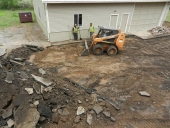posted 9 years ago
Intent--helping out a driveway that's already here, to capture more of the water running off it and have less of it erode during rainfall.
I had this idea, that we could turn the middle of the drive into some kind of "swale pits". They would be filled with chipped wood, down to a depth of about two feet, surface diameter about the same --2 feet--and be space far enough apart that they wouldn't collapse into one another.
They would be in the center of the road, leaving two tracks for the cars to go around them. In other words, the car tires will be able to drive on the edges of the road just fine, but the middle will soak in more water.
When it rains (it just was a torrential sudden rain after lots of dry days) the water streams down the rivulets on top of the road, and it turns brownish, with dissolved or loosened clay. The road is gravel, though mostly the gravel seems to have disappeared and there are just larger stones and compacted clayish hardpan. The grade is between %7 and %10 in the part I'm looking at, to be conservative, so within the 15% guideline I have read is allowable for swale construction.
The soil around here in general is clayey to the max. It's part wetland, rains hard frequently but not consistently. The road is not on contour nor is it not the ridge line, exactly, unfortunately, and it has been culverted a bit with gravel culverts a while ago. There's fairly good drainage down into somewhere at a spot near the bottom of the drive (I think that must have been put there deliberately--a gravel pit going deep into the ground and into the water table).
The water table here has famously been super-high, when we tried to dig pits high up on the hill above the top of the drive for burying something it filled in with water one time. but now that I think about it that doesn't quite make sense. It's a hill, how can the water table be high at the top of the hill? doesn't that mean that there's actual flow, not a table? So I think that it's false springs rather than the actual "water table" (not sure how the terms are used technically). I saw a puddle up there earlier today. Everything is dry, the upper stream bed bone dry, and yet this puddle was sitting there in the middle of the top of the road filled with water and breeding larvae of the Future Young Mosquito Leaders of America. It is weirdly not draining. Clay.
This is in the Taconics, not at my profile location. We're around Albany, 5b. This was Mohican country before European settlers.
Questions:Is this a workable idea? is it a good enough idea to be worth implementing? what could go wrong? if it means you can't turn around on part of the road (we wouldn't put in the pits everywhere, leaving the intersections as places you can pass another car or turn around) would that be a problem? if you can't pull over just anywhere is that a problem? how much would the wood pits compact if you did drive over them? is swale-ing in soil this clayey a waste of time anyway if we can't also somehow alter it to be more absorbent?
Advantages:
--disrupting the road is not disrupting much of an ecosystem, it's about as lifeless as it can get
--it's hard to swale in other places because we'd certainly disrupt tree roots, whole trees, or small plants, some of which are endangered species (jack in the pulpit, trillium, etc.)
--can soak in more of the vast amounts of water that come onto the land sporadically
--could help the health of the soil deeper down and potentially have benefits spreading out to the sides of the road if the soil takes up more water
Disadvantages:
--clay, clay, and clay
--potential problems for cars going up and down; you couldn't turn around on parts of the road
Community Building 2.0: ask me about drL, the rotational-mob-grazing format for human interactions.





 1
1












 1
1




 1
1




 1
1








![Filename: topo-plan-map.jpg
Description: plans [Thumbnail for topo-plan-map.jpg]](/t/45426/a/26992/topo-plan-map.jpg)































